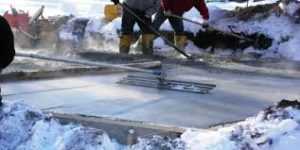
Pouring concrete in cold weather is something we do a lot in New York. The months of November all the way to March usually have many days with temperatures that are cold as sh*t, which isn’t great for concrete workers, but definitely workable.
Since Biordi Concrete is a business that runs on pouring concrete, we cannot let the cold weather to stop us.
Below are a few things to consider before pouring concrete in the winter:
1. SCHEDULE THE POUR IN ADVANCE
Get in contact with a ready mix company that you use at least 2-3 days in advance if possible (depending on the size of the pour). Ready mix companies are more flexible during the winter months being that if Mother Nature doesn’t want you to pour that day, than you aren’t pouring that day and you must wait a day or two when the weather is cooperating.
2. THE WEATHER THE DAY OF THE POUR
The rule of thumb that we use is that we pour concrete when the temp is 32° and rising. If the concrete has hot water mixed with it (120 degrees F) the concrete temperature should be around 65 – 70 F when you dump it on the ground. Then the heat from hydration will be enough to get it to set up.
3. IS THE SUB-BASE FROZEN?
ALWAYS check the sub-base for frost before you pour. If the ground has any frost on it, do not pour. The sub-base has to be completely thawed at least 4” to 6” down before you pour concrete on it. If you don’t remove the frozen sub-base, concrete will crack when the ground un-thaws. Obviously you are replace the frost subbase with blend/gravel that is not frozen.
4. ORDER WINTER CONCRETE
Using the right concrete mix is ESSENTIAL during a winter pour. We usually pour 4000psi with hot water and an accelerator in the concrete. An accelerator can help offset the effects of low temperatures by increasing the rate of cement hydration. This aids in the concrete setting time and the development of early strength in the concrete.
5. AFTER THE CONCRETE IS POURED
You may have to wait longer than you usually do in warmer weather before you get on it to start troweling. Let the concrete dry, don’t touch it for a little – the more you play with the concrete the longer it will take to dry.
6. ONCE THE CONCRETE IS FINISHED
After the concrete is finished, the next step is to protect it from freezing. What we’ve found works best is covering the concrete with burlap (so the concrete doesn’t get scratched) then insulating concrete blankets on top of the burlap. This keeps the concrete nice and warm for days. In order to keep the wind from blowing the blankets, we place 2×4’s all around to keep blankets from flying away. We usually keep the blankets on (depending on the cold) for 24-48 hours.